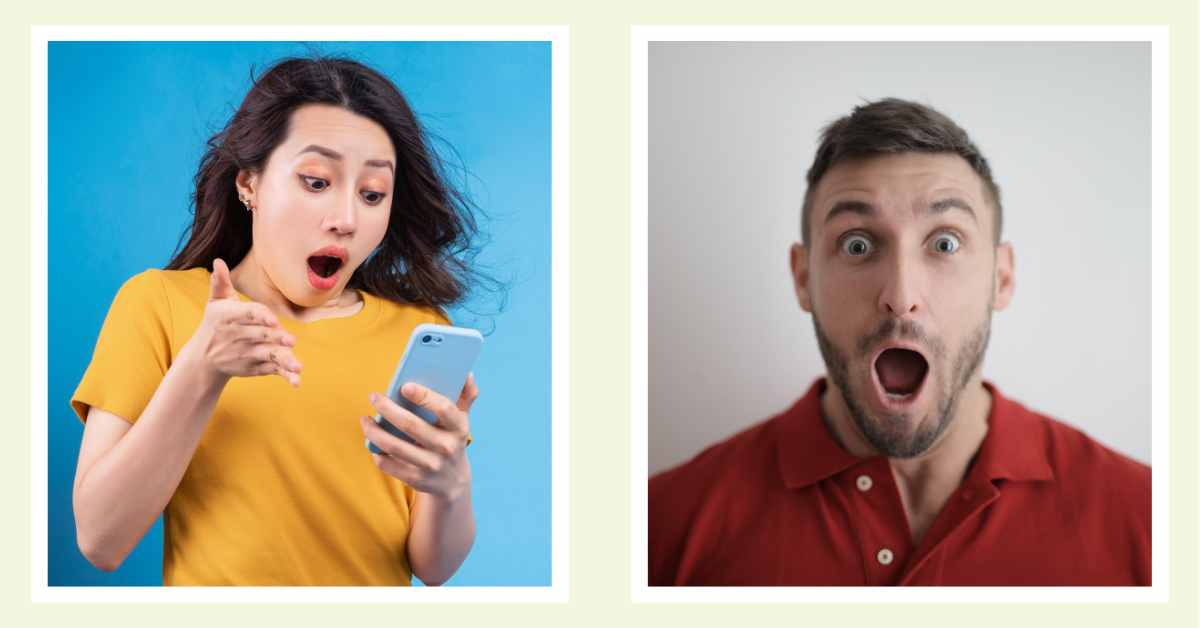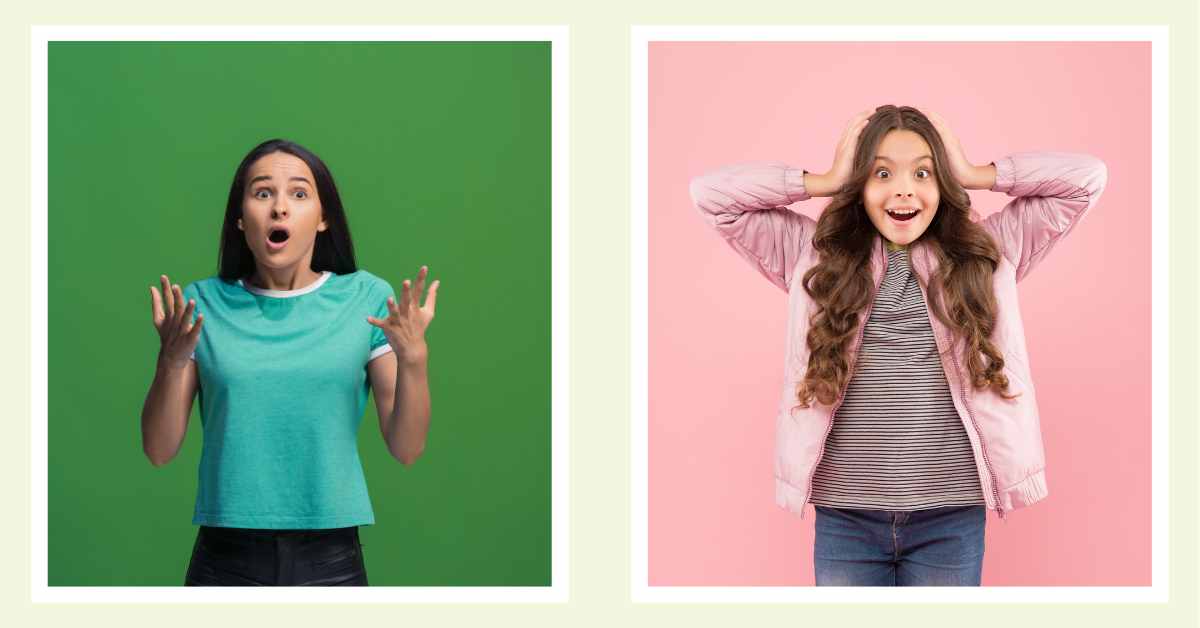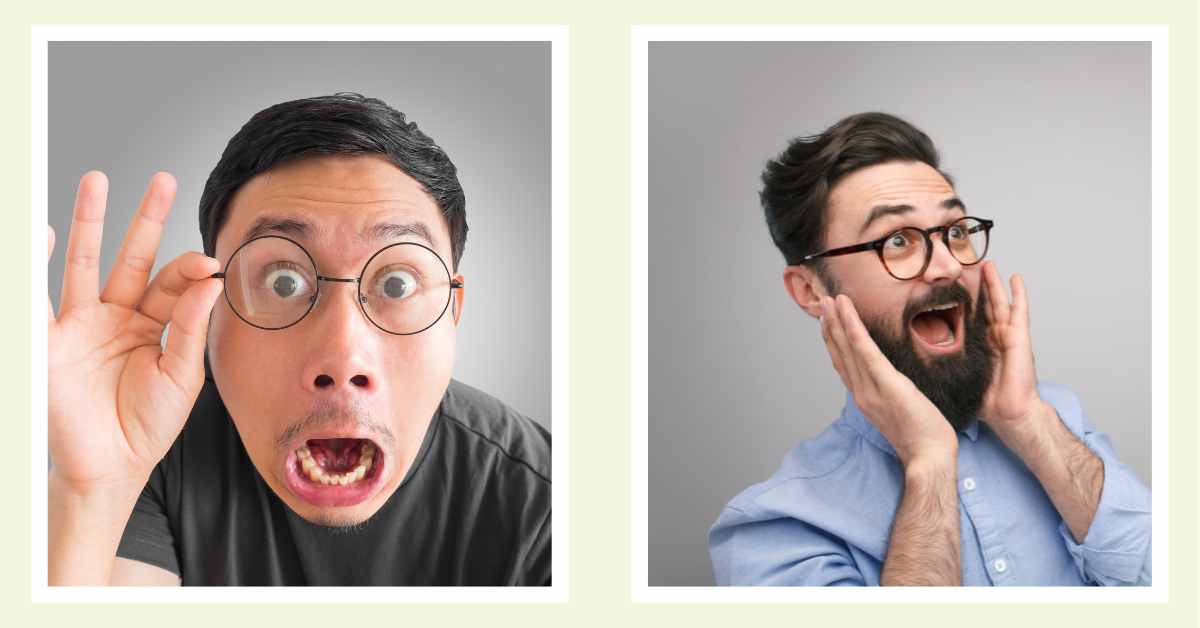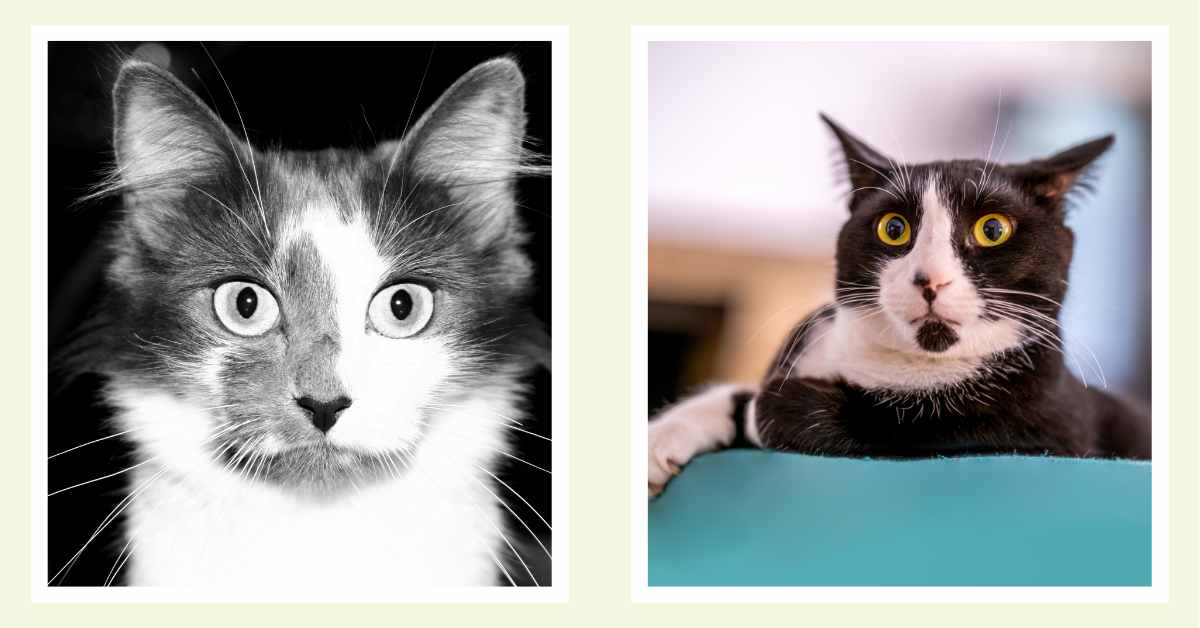The surprised face emoticon is a digital expression of shock, astonishment, or disbelief. A simple symbol or image, it has become a staple in online communication. From casual chats to formal emails, it’s a versatile tool that can add color and nuance to your messages.
In this post, we’ll explore the different ways this emoticon is represented, from basic text symbols to detailed graphics. We’ll also discuss how and when to use it effectively.

Outline
Toggle- What Is The Surprised Face Emoticon?
- So Are Emoticons And Emojis Different?
- History And Evolution
- Different Symbols And Their Meanings
- Surprised Emoticons And Their Meanings
- How Is The Surprised Face Emoticon Used Across Platforms
- Cultural Impact – Surprised Face Emoticon
- How To Use The Surprised Face Emoticon Effectively
- Facts About Surprised Face Emoticon
- Surprised Face Images & Pictures
- FAQs:
What Is The Surprised Face Emoticon?
The surprised face emoticon, often represented by symbols such as ???? or ????, is a digital icon used to express shock, amazement, or sudden disbelief. This emoticon captures a wide-eyed expression paired with a small ‘o’ shaped mouth, universally recognized as a symbol of surprise. Its simplicity allows users across different cultures and languages to convey a powerful emotion quickly and effectively.
The use of this emoticon spans various contexts—from personal messaging to professional emails—where words fall short of expressing immediate reactions. By incorporating the surprised face emoticon, digital communication becomes more expressive, enhancing the emotional depth of our interactions without the need for elaborate descriptions.
So Are Emoticons And Emojis Different?
Yes, emoticons and emojis are different, though they are often used interchangeably in casual conversation. Here’s how they differ:
Emoticons
- Definition: Emoticons are combinations of keyboard characters that create a visual representation of a facial expression, emotion, or other symbol.
- Examples:
- 🙂 (smiley face)
- 🙁 (sad face)
- 😉 (winking face)
- ¯_(ツ)_/¯ (shrugging)
- Origin: Emoticons have been used since the early days of the internet and are created using standard keyboard characters.
- Customization: Emoticons can vary widely based on the creativity of the person creating them, as they are simply text-based.
Emojis
- Definition: Emojis are pictorial symbols that represent facial expressions, objects, places, weather, animals, activities, and more.
- Examples:
- ???? (grinning face)
- ???? (crying face)
- ???? (cat)
- ???? (party popper)
- Origin: Emojis were first developed in Japan in the late 1990s by Shigetaka Kurita and have since become widely used across all digital platforms.
- Customization: Emojis are standardized by the Unicode Consortium, which means they have specific designs that are consistent across devices and platforms, though the exact appearance might slightly differ depending on the platform (e.g., iOS vs. Android).
Key Differences
- Creation:
- Emoticons are created using text characters.
- Emojis are graphical images encoded as characters.
- Complexity:
- Emoticons are usually simple and rely on the user’s interpretation of text.
- Emojis are visually detailed and universally recognized symbols.
- Platform Support:
- Emoticons can be used on any device with a keyboard.
- Emojis require a platform or software that supports Unicode emojis.

History And Evolution
The history of the surprised face emoticon traces back to the early days of emoticons when punctuation marks were first used to create expressive faces in text.
Originating from the typographic emoticons of the 1980s, the surprised face began as a simple combination of characters: :-O. As digital communication evolved, these text-based symbols transformed into the graphical emojis we use today. This evolution was influenced by the need to express emotions more vividly and universally in an increasingly connected world.
The introduction of Unicode and the standardization of emojis further cemented the surprised face emoticon as a staple in our digital lexicon, reflecting its enduring appeal and functionality across diverse platforms and devices.

And when it comes to emojis, they originated in Japan in 1999, created by Shigetaka Kurita for the mobile communications company NTT DoCoMo. As of today, over 10 billion emojis are sent every day around the world, highlighting their widespread use in digital communication (Sixth City Marketing). This vast usage underscores how integral emojis have become to the way people interact online, with a significant impact on both social and professional communications.
Different Symbols And Their Meanings
The surprised face emoticon is represented by a range of symbols, each carrying subtle nuances in expression that can convey different levels of surprise or shock. Here, we explore some common variations and the nuances they bring to digital communication:
- ???? (Astonished Face): This emoji features wide-open eyes and a round mouth, often used to express genuine shock or amazement. It’s suitable for situations where the surprise is profound and unexpected.
- ???? (Hushed Face): With slightly open eyes and an oval mouth, this emoji is milder and often used to convey mild surprise or disbelief without the intensity of the astonished face.
- ???? (Face with Hand Over Mouth): This symbol combines surprise with a playful element, often used when the surprise is pleasant or when concealing a laugh.
- ???? (Face Screaming in Fear): This is an extreme version of the surprised emoticon, where the eyes are wide and the mouth is wide open in a scream. It’s typically used in contexts of fear, horror, or overwhelming shock.
- ???? (Weary Cat Face): A variant from the animal category, this depicts a cat with wide eyes and an agape mouth, mirroring the human expression of shock but adding a whimsical or cute element to the message.
Here is a table that summarizes these emojis and their typical uses:
| Emoji | Name | Typical Use |
| ???? | Astonished Face | Deep surprise or shock |
| ???? | Hushed Face | Mild surprise or disbelief |
| ???? | Face with Hand Over Mouth | Playful surprise or concealing laughter |
| ???? | Face Screaming in Fear | Extreme shock, horror, or fear |
| ???? | Weary Cat Face | Whimsical or cute expression of surprise |
Surprised Emoticons And Their Meanings
(; ꒪ö꒪) – Extremely surprised
╭( ๐_๐)╮ – Shocked or stunned
(;° ロ°) – Startled or amazed
∑(; °Д°) – Shocked disbelief
(∵) – Wow! or amazed
(○(●●)○) – Wide-eyed surprise
(⚆ᗝ⚆) – Astonishment
( ◐ o ◑ ) – Surprised and curious
⋋| ◉ ͟ʖ ◉ |⋌ – Intense surprise
ต(ꏿ᷅௰ꏿ᷄)ต – Shocked and upset
\(๑•́o•̀๑)/ – A mix of surprise and confusion
⌒(,,๏ ⋏ ๏,,)⌒ – Cute surprise
/(=๏ x ๏=)\ – Bunny surprise
(◯Δ ◯ ∥) – Dumbfounded or speechless
(๑ơ艸ơ๑) – Playful surprise
(⊙︿⊙ ✿) – Surprised and sad
(ʘᗩʘ’) – Shocked beyond words
(○□○) – Surprised and scared
( ‘◇’) – Simple surprise
(✿〇∀〇) – Floral surprise
(!! ´◯`)∑ – Sudden realization
( Ŏ艸Ŏ) – Childish surprise
☉Ô☉ – Wide-eyed shock
╭(* _ *)╮ – Overwhelmed
(>0<;;;)- Nervous surprise
<(“0 “)> – Fish-like surprise
〣 ( ºΔº ) 〣 – Intense shock
(ὀ⌓ὀ⑅) – Mild surprise
┌╏ º □ º ╏┐ – Bewilderment
(ᵒ̤̑ ₀̑ ᵒ̤̑) wow!*✰ – Exaggerated surprise
٩(●ö●)۶ – Excited surprise
(๑♡ ⌓♡๑) – Surprised and in love
(゚o゚〃) – Shocked and embarrassed
(☉௰☉ິັ໌໋໊) – A mix of surprise and confusion
ヽ(๏ ∀๏ )ノ – Cheerful surprise
( ;ↀ⌓ↀ) – Surprised and suspicious
@(。・0・)@ – Monkey-like surprise
(「 ⊙Д⊙)「 – Reaching out in surprise
(◎0◎) – Wide-eyed in shock
((; ఠ ਉ ఠ)) – Nervous shock
( ゚ Д゚) – Surprised and confused
∑(ΦдΦlll) – Surprised and sweating
c( O.O )ɔ – Bird-like surprise
╰། ◉ ◯ ◉ །╯ – Bewildered and concerned
੧[ ⁰ o ⁰ ]ʋ – Open-mouthed surprise
How Is The Surprised Face Emoticon Used Across Platforms
The surprised face emoticon has found its way across various digital platforms, each adapting its use to suit specific communication styles and audiences. Below, we explore how this emoticon is utilized differently across several key platforms:
- Social Media (Facebook, Twitter, Instagram): On these platforms, the surprised face emoticon is frequently used in reactions to posts, comments, and stories. It serves as a quick way to express shock or amazement at surprising news or unexpected events shared by others.
- Messaging Apps (WhatsApp, Telegram, SMS): In personal and group chats, this emoticon helps convey sudden emotional responses more vividly than text alone. It’s especially useful in fast-paced conversations where typing out a full response might delay the flow of interaction.
- Emails: In more formal digital communications like emails, the use of emoticons, including the surprised face, is less common but growing. When used, it’s typically to soften a reaction or to express surprise in a lighter, more informal tone within a professional context.
- Forums and Online Communities (Reddit, Quora): Here, the surprised face emoticon adds a visual element to discussions, often highlighting a user’s reaction to unexpected twists in a narrative or shocking revelations in a thread.
- Gaming Platforms (Twitch, Discord): Within gaming communities, these emoticons are part of the everyday lexicon, used both in live chats and in-game communications to react to surprising gameplay moments or plot developments.
Cultural Impact – Surprised Face Emoticon
The surprised face emoticon has not only enriched our digital communications but also influenced cultural norms and expressions globally. Its widespread use reflects a cultural shift towards more visually expressive and emotionally nuanced digital interactions. Here’s how this simple symbol has impacted various aspects of culture:
- Enhancing Emotional Expressivity: The emoticon allows individuals to express emotions more vividly and immediately, transcending language barriers. It adds a layer of emotional depth to messages, making digital conversations feel more personal and empathetic.
- Global Understanding: Due to its universal design, the surprised face emoticon is recognizable across different cultures, promoting a shared understanding of emotional expressions. This universality helps foster communication between people from diverse backgrounds.
- Influence On Language: Emoticons like the surprised face are increasingly being integrated into formal languages, influencing how we write and communicate. They have become a part of everyday vocabulary, illustrating the evolution of language in the digital age.
- Marketing And Advertising: Brands often utilize emoticons, including the surprised face, in their digital marketing strategies to appear more relatable and to enhance the emotional appeal of their messages. This strategy has proven effective in engaging younger audiences who are fluent in digital language.
- Art And Media: The surprised face emoticon has inspired various forms of art and media, where it is used to express themes of surprise and emotional depth. It appears in everything from digital art installations to clothing, showcasing its cultural significance beyond mere communication.
How To Use The Surprised Face Emoticon Effectively
Using the surprised face emoticon effectively can enhance your digital communication by accurately conveying emotions of shock or surprise. Here are some guidelines to help you use this emoticon appropriately across different contexts:
- Understand The Context: Before using the surprised face emoticon, consider the context of the conversation. It is suitable for casual chats but might be less appropriate in very formal or sensitive communications unless the setting has become informally established.
- Choose The Right Variant: As discussed earlier, different surprised face emoticons convey varying degrees of surprise. Choose the one that best fits the intensity of your emotion and the situation to ensure your message is understood as intended.
- Combine With Text: While emoticons are powerful, combining them with text can clarify your intent and provide additional context. This is especially important in professional settings where misinterpretations can have consequences.
- Frequency Of Use: Overusing emoticons can dilute their impact and may make your messages seem less serious or professional. Use the surprised face emoticon sparingly to maintain its effectiveness as a tool for expressing genuine surprise.
- Cultural Considerations: Be mindful of cultural differences in the interpretation of emoticons. What is considered an appropriate expression of surprise in one culture may be perceived differently in another.
Facts About Surprised Face Emoticon
- Historical Roots: The surprised face emoticon, particularly its precursor ‘
‘, originates from the emoticons developed in the early internet and chatroom era. It represents one of the earliest attempts to convey human expressions and emotions digitally, showcasing how users have always sought to inject emotional depth into text-based communication. - Cross-Platform Consistency: Despite variations in design across different platforms, the fundamental expression of the surprised face emoticon remains consistent. This consistency ensures that the emotion of surprise is universally understood, regardless of the device or service used.
- Impact on Communication Trends: The popularity of the surprised face emoticon has influenced the development of newer, more nuanced emoticons and emojis. Its widespread use demonstrates the demand for expressive flexibility in digital communication, paving the way for a richer, more expressive emoji language in modern texting and online chats.
Surprised Face Images & Pictures
Surprised Pikachu Face Images

Surprised Cat Face Images

Surprised Face Expressions Pictures







FAQs:
The surprised face emoticon typically signifies shock, amazement, or unexpected surprise, used to express strong emotional reactions in digital communications.
Yes, it can be used in professional emails when appropriate, especially in less formal contexts to convey surprise or light-heartedness effectively.
Yes, most platforms have their own design variations of the surprised face emoticon, though all convey similar expressions of surprise.
Cultural differences can influence how emoticons are interpreted; what is considered playful in one culture might be seen as inappropriate in another.
Yes, this emoticon is universally understandable and suitable for all age groups, making it a versatile choice for digital communication.
The most common mistake is using it in inappropriate contexts, where the level of formality or the emotional tone does not align with such expressions.
Its usage has evolved from simple text-based characters to more sophisticated, graphic representations as digital communication has become more visually oriented.
While it can emphasize or complement verbal messages, it should not completely replace words, especially in contexts where clarity is crucial.
It generally makes conversations more lively and expressive, adding a layer of emotion that might be lacking in text-only communication.
Use it sparingly to enhance communication without overwhelming the message and consider the recipient’s culture and the conversation’s context.



